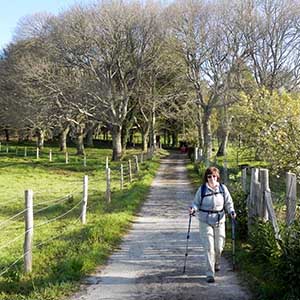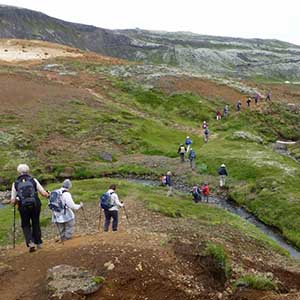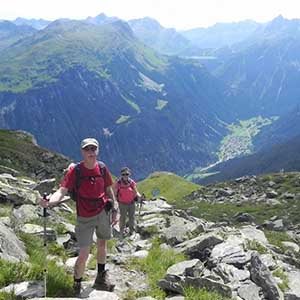Hiking Levels and Fitness
Hiking Levels
Hikes range in length from 10 to 23 km each, depending on the trip, and some may have dropout points. Your hike leader will go into greater detail about each hike with you. All the hikes are optional; you can do as many or as few of them as you wish. Each holiday is rated based on the degree of difficulty of the hikes.
Our rating system is as follows:

LIGHT
Easy walking terrain with a minimal amount of ascent. Trails are well travelled. No bushwhacking.

MODERATE
Moderate terrain with ascents and descents on some of the hikes of up to 500 ft. Trails are usually well marked but may sometimes be hilly. May involve light bushwhacking, some rough spots or obstacles. Hiking boots necessary.

CHALLENGING
More challenging terrain with climbs on some of the hikes of up to 3000 ft. Trails are not always very well marked or well-travelled. May involve steep ascents/descents, rock scrambling or other obstacles, and some bushwhacking. Hiking boots necessary.
Warm-up and Fitness
PREVENT SORE AND ACHING MUSCLES by stretching after and during the hike. Vigorous activity like hiking causes lactic acid to build up in the muscles. Stretching after the hike squeezes this acid out and helps prevent you feeling stiff and sore next day. Some suggested stretches are shown below. It is not wise to stretch before the hike when your muscles, ligaments and tendons are cold - you could easily injure yourself. Wait until the first rest stop when you will have warmed up sufficiently to do some of these stretches:
Hip Stretch (for hip flexor). From a kneeling position, bring right foot forward until knee is directly over ankle; keep right foot straight. Rest left knee on floor behind you. Leaning into front knee, lower pelvis and front of left hip toward floor to create an easy stretch. Hold for 10 to 30 seconds, then switch legs and repeat.
Spinal Twist (for back and sides). Sit with right leg straight out, and left knee bent, with left food placed on the outside of right knee. Bend right elbow and place it on outside of upper left thigh, just above knee, to keep that leg stationary. Place left hand behind you, slowly turn head to look over left shoulder, and twist upper body toward left arm. Hold for 10 to 30 seconds. Switch sides and repeat.
Thigh Stretch (for hamstrings). Lie on back with both knees bent. Grasp behind the right thigh with both hands and pull toward chest. Slowly straighten leg, keeping foot relaxed. Hold for 10 to 30 seconds, then lower leg. Switch legs and repeat.
Thigh Stretch (for quadriceps). Placing left hand against wall for balance, grab right ankle with right hand and pull gently toward buttocks for 10 to 30 seconds. Do not arch back. Switch sides and repeat.
Lumbar Stretch (for lower back). Lying on back, clasp one hand under each knee. Gently pull both knees toward chest, keeping lower back on floor. Hold for 10 to 30 seconds, relax, then repeat.
Calf Stretch (for gastronemius and soleus muscles). Stand 2 to 3 feet from a wall, with feet perpendicular to wall, and lean against it for 10 to 30 seconds. Keep feet parallel to each other; make sure rear heel stays on floor. Switch legs and repeat. Variation: keep rear knee slightly bent during stretch.


